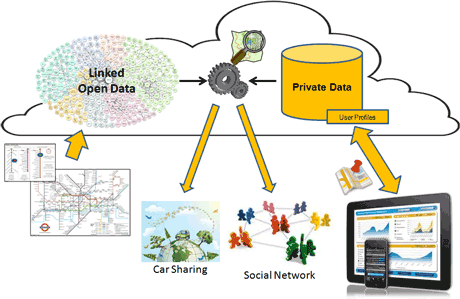by Carlos E. Cuesta, Paloma Cáceres, Belén Vela and José María Cavero
Mobile systems are becoming ubiquitous, which, in combination with wide-range service-oriented architectures, offers enormous potential for a range of uses. In this context, we have developed the CoMobility platform, a system designed to integrate carpooling and the use of public transport networks, with the goal of reducing energy consumption and CO2 emissions. CoMobility defines a service-oriented platform to help mobile users plan their use of transport, including sharing, with the purpose of saving both energy and money.
Mobile systems are not only useful in their ability to provide pervasive access to computing systems (ie enabling computer access anywhere), but they also provide the inputs of a mobile and dynamic environment into a computational system; it is now possible to perform computations that, until recently, were simply impossible. A classic example is geolocation; it is now easy to provide the physical location of a user, and to use this data for a variety of purposes.
In particular, such data can be used in the context of transportation. Transport is an important issue in modern societies, especially in big cities, and represents a significant proportion of global energy consumption. In many cases, energy consumption can be significantly reduced by an efficient use of transport media. Not only is choosing the right path within the transport network important, but also being able to share a vehicle (including private vehicles) with others. There are several initiatives assisting people in sharing transport, the most popular being carpooling: more than one person sharing a car.
However, no existing solution combines private transport sharing with the use of public transport, which would make it more flexible. We have designed an IT platform, called CoMobility, to assist in intermodal transport sharing, integrating the use of carpooling with public transport, as well as other private transport media.
To take advantage of this approach, individuals must be convinced of the benefits of reducing the number of private cars, and of the need of a new model of transport. For this purpose, our CoMobility platform has "customized" analytics on savings and energy consumption, to make individuals aware of the benefits of this new way of travelling. These data are obtained by combining private data from carpooling, and open data from public transport networks, and from energy-aware institutions.
Our system requires the integration of two types of data set: private data (provided by private providers and consumers of the transport system) and open data (ie data from public transport networks and public institutions). The format of public data within the open data initiatives prevents non-experts from using them directly, and thus it requires additional semantics, as provided by “Linked Open Data” [1][2] .
In summary, CoMobility provides a systematic approach to (i) accessing open, integrated and semantically annotated transportation data and street maps, (ii) combining them with private data, and (iii) supplying mechanisms to allow the actors to share and search these data. Therefore, the CoMobility conceptual architecture provides the means to perform the following tasks (also depicted in Figure 1).

First, the platform can identify, select, extract and integrate data from different and heterogeneous sources, stemming from the transportation, geographical and energy domains. Second, data from public institutions is obtained automatically in the form of open data. Third, these data are annotated as linked data, and a set of heuristics generate links between data items from different sources without human intervention. Fourth, these data are integrated with private data provided by users themselves. And finally, CoMobility provides intuitive and customized data analytics and visualization, allowing individuals to become aware of the environmental impact of their transport choices.
The CoMobility platform is provided on the Internet “as a service”, where both public transport information and data provided by users themselves are stored and accessed “in the cloud”. The cloud approach is necessary as scalability is one of the most important requirements of this kind of wide-range service architecture. The platform needs to access a great amount of data, which is also stored in the cloud – both the private data of carpoolers, and the public data accessed in a linked open data approach. Users are able to access their information in several formats, particularly in mobile devices (currently, Android devices) and web applications. Through these devices, they are able to plan their paths in the transport network, moving from a shared car to the underground, and from there to a bus line; and at the same time receiving an estimation of the saving of both money and energy.
With this system, we hope to encourage social and individual change towards a new - more efficient and environmentally friendly - model of transport.
Link:
VorTIC3 Research Group (Rey Juan Carlos University): http://www.vortic3.com
Reference:
[1] Linked Open Data. http://linkeddata.org/
[2]T. Heath, C. Bizer: “Linked Data: Evolving the Web into a Global Data Space”, Morgan & Claypool, 2011.
Please contact:
Carlos E. Cuesta, Paloma Cáceres, Belén Vela and José María Cavero
VorTIC3 Research Group, Rey Juan Carlos University, Madrid, Spain
E-mail:











